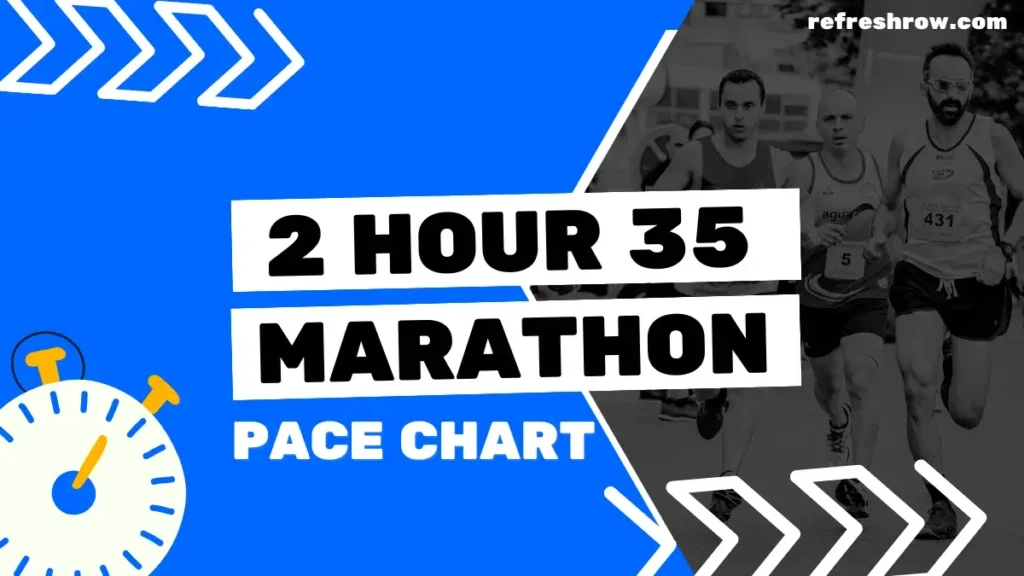To run a 4:10 hour marathon you need to run at a pace of 9:32 per mile or 5:55 per kilometer.
Following the splits below (and shaving off a second), you’ll run a sub 4:10 marathon.
I’d recommend aiming to run 1-2 minutes ahead of the split target time from 10 miles, as you’ll likely come up against crowding on race day.
4:10 Marathon Pace in Miles
| Mile | Split |
|---|---|
| 1 | 9:32 |
| 2 | 19:04 |
| 3 | 28:36 |
| 4 | 38:08 |
| 5 | 47:41 |
| 6 | 57:13 |
| 7 | 1:06:45 |
| 8 | 1:16:17 |
| 9 | 1:25:49 |
| 10 | 1:35:21 |
| 11 | 1:44:53 |
| 12 | 1:54:25 |
| 13 | 2:03:57 |
| 14 | 2:13:30 |
| 15 | 2:23:02 |
| 16 | 2:32:34 |
| 17 | 2:42:06 |
| 18 | 2:51:38 |
| 19 | 3:01:10 |
| 20 | 3:10:42 |
| 21 | 3:20:14 |
| 22 | 3:29:46 |
| 23 | 3:39:19 |
| 24 | 3:48:51 |
| 25 | 3:58:23 |
| 26 | 4:07:55 |
| 26.2 | 4:10:00 |
Download
4:10 Marathon Pace in KM
| KM | Split |
|---|---|
| 1 | 5:55 |
| 2 | 11:51 |
| 3 | 17:46 |
| 4 | 23:42 |
| 5 | 29:37 |
| 6 | 35:33 |
| 7 | 41:28 |
| 8 | 47:24 |
| 9 | 53:19 |
| 10 | 59:15 |
| 11 | 1:05:10 |
| 12 | 1:11:06 |
| 13 | 1:17:01 |
| 14 | 1:22:57 |
| 15 | 1:28:52 |
| 16 | 1:34:48 |
| 17 | 1:40:43 |
| 18 | 1:46:39 |
| 19 | 1:52:34 |
| 20 | 1:58:30 |
| 21 | 2:04:25 |
| 22 | 2:10:21 |
| 23 | 2:16:16 |
| 24 | 2:22:12 |
| 25 | 2:28:07 |
| 26 | 2:34:03 |
| 27 | 2:39:58 |
| 28 | 2:45:54 |
| 29 | 2:51:49 |
| 30 | 2:57:45 |
| 31 | 3:03:40 |
| 32 | 3:09:36 |
| 33 | 3:15:31 |
| 34 | 3:21:27 |
| 35 | 3:27:22 |
| 36 | 3:33:18 |
| 37 | 3:39:13 |
| 38 | 3:45:09 |
| 39 | 3:51:04 |
| 40 | 3:57:00 |
| 41 | 4:02:55 |
| 42 | 4:08:51 |
| 42.2 | 4:10:00 |
Download
Other Marathon Pace Charts
Targeting a different time?
Check out the Full Marathon Pace Chart in Miles or KM
Or select a specific finishing time below:
| 3:00 | 4:00 | 5:00 | |
| 3:05 | 4:05 | 5:15 | |
| 3:10 | 4:10 | 5:30 | |
| 3:15 | 4:15 | 5:45 | |
| 3:20 | 4:20 | 6:00 | |
| 3:25 | 4:25 | 6:15 | |
| 2:30 | 3:30 | 4:30 | 6:30 |
| 2:35 | 3:35 | 4:35 | 6:45 |
| 2:40 | 3:40 | 4:40 | 7:00 |
| 2:45 | 3:45 | 4:45 | |
| 2:50 | 3:50 | 4:50 | |
| 2:55 | 3:55 | 4:55 |
Training for a 4:10 Marathon
Is 4:10 a Good Marathon Time?
Well, what do the stats say?
Run Repeat conducted a study that contains 19,614,975 marathon results from more than 32,335 races across the globe, here is how a 4:10 marathon compares against age and gender for the races recorded:
| Overall | You’re faster than 64.40% of all runners. |
| Male | You’re faster than 54.3% of males. |
| Female | You’re faster than 78.0% of females. |
| <20 | You’re faster than 61.8% of under 20s. |
| 20-29 | You’re faster than 58.2% of 20-29 year olds. |
| 30-39 | You’re faster than 57.9% of 30-39 year olds. |
| 40-49 | You’re faster than 62.2% of 40-49 year olds. |
| 50-59 | You’re faster than 73.7% of 50-59 year olds. |
| >60 | You’re faster than 88.1% of over 60s. |
Training Runs and Paces for a 4:10 Marathon
To break a 4:10 marathon you’ll need to do some serious distance in your training, I recommend at least 15 miles (24km) per week.
You’re also going to need to make sure you’ve crossed off these milestones for other race distances:
- A 5k in 26:00 mins
- A 10k in 54:20 mins
- A half marathon in 1 hour 56 mins
Training Paces
| Pace | Mins per Mile | Mins per KM |
|---|---|---|
| Easy | 10:44 | 6:40 |
| Steady | 09:32 | 5:55 |
| 10k | 8:44 | 5:26 |
| 5k | 8:23 | 5:12 |
| 1 Mile | 7:47 | 4:52 |
Weekly Mileage Targets
| Target Mileage: | Gradually increase your weekly mileage from 25 miles (40 km) to a peak of 40 miles (64 km). |
| Incremental Increase: | Increase mileage by approximately 10% each week, with every fourth week as a recovery week where mileage is reduced by 20-30%. Make sure to taper for the last 1-2 weeks. |
Long Run Structure
| Total Distance: | Build up to long runs of 20-22 miles (32-35 km). |
| Segment Example: | First 5 miles (8 km): Easy pace, heart rate 140-150 bpm (approximately 11:15/mile or 7:00/km). Next 1 mile (1.6 km): Fast pace at 8:10/mile (5:04/km). Next 5 miles (8 km): Medium effort, heart rate around 160 bpm (approximately 9:10/mile or 5:41/km). Repeat: Repeat the segment twice (5 miles easy, 1 mile fast, 5 miles medium), you can taper the final 2 miles if required. |
Why This Works: Incorporating varied paces within long runs enhances lactate tolerance, which helps on race day when you’ve got to maintain pace despite feeling fatigued. By practicing surges during a run, you can build up your physical and mental resilience (lots of elite marathon runners use these strategies during their training)
Alternating Long Runs: Alternate between structured long runs (easy/fast segments) and easier long runs. For easier long runs, maintain a steady, comfortable pace throughout, focusing on mileage rather than speed to aid recovery.
Speedwork Sessions
| Short Intervals: | – 800m repeats at 4:00 per interval (4:58/km). – Aim for 6-12 repetitions with equal time for recovery. |
| Mile Repeats: | – 1 mile repeats at 8:10 per mile (5:04/km). – Aim for 6-12 repetitions with a 1-2 minute recovery jog. |
| Longer Intervals: | – 2 mile repeats at 8:20 per mile (5:10/km). – Aim for 5-8 repetitions with a 2-3 minute recovery jog. |
Recovery and Rest Days
| Rest Days: | You don’t need to incorporate rest days if you are using recovery runs, but I recommend taking 1 (or a max of 2) per week to allow your body to recover and prevent overtraining. |
| Easy Run Days: | Include 1-2 easy run days per week at a relaxed pace of 11:30/mile (7:09/km), covering 5-10 miles (8-16 km) per day. Try to keep your heart rate below 140 bpm on easy days to ensure proper recovery and aerobic development. |
My Tips to Run a Sub 4:10 Marathon
Time on Your Feet, Not Just Miles
When you’re training, it’s important to think beyond just hitting a certain mileage each week.
Make sure you’re also focusing on the amount of time you’re spending on your feet during your long runs.
This approach helps your body adapt to the duration of the marathon, not just the distance.
For example, I’d aim to spend at least 3-3.5 hours on your feet during your longest runs to try and simulate race day as much as you can.
This strategy can help to build endurance and feel more prepared and less fatigued in the final miles.
Practice Running on Tired Legs
Another way to practice race day conditions is to get your legs accustomed to running while fatigued.
This technique is often overlooked but can be a game-changer.
Incorporate back-to-back training sessions where you do a long run on say a Saturday, followed by a shorter, yet still challenging, run on Sunday.
This mimics the fatigue you’ll experience in the final miles of the marathon, training your body/mind to push through when the going gets tough.
(be careful not to overdo it though, rest days are important, so don’t push it to injury).
Stay Consistent with Midweek Mileage
It’s easy to focus on long runs as the cornerstone of your marathon training, but don’t underestimate the importance of midweek mileage.
Consistent midweek runs, especially those in the 5-10 mile range, are key to building the overall endurance and help you build up that CV of miles.
These runs help you maintain fitness and build cumulative fatigue, which is crucial for simulating the marathon experience.
Keep your pace steady and comfortable, focusing on consistency rather than speed.
Over time, these midweek runs will enhance your stamina and ensure you’re well-prepared to tackle the full marathon distance.
Train in All Conditions
Don’t let bad weather keep you indoors – training in various weather conditions can give you a huge advantage on race day.
Whether it’s rain, wind, or heat, experiencing these elements during your training prepares you mentally and physically for whatever race day might throw at you.
If you’ve already run in tough conditions, you’ll feel more confident and less stressed if the weather isn’t perfect on race day.
Plus, training in different weather helps you figure out the best gear and clothing choices for various conditions.
If you know your marathon is likely to be in very different conditions (e.g. much hotter) than your local climate, if it’s feasible, try and get come training runs in in that climate to get used to it.


Row Brown is the founder of Refresh Row. He is a keen marathon runner, his favorite being the London Marathon. He’s now set himself the mission of Running the Entire Length of Spain, which is scheduled for late 2024.


